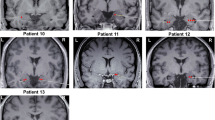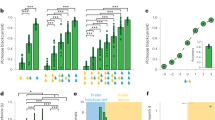Abstract
The orbitofrontal cortex (OFC) is implicated in emotion and emotion-related learning. Using event-related functional magnetic resonance imaging (fMRI), we measured brain activation in human subjects doing an emotion-related visual reversal-learning task in which choice of the correct stimulus led to a probabilistically determined 'monetary' reward and choice of the incorrect stimulus led to a monetary loss. Distinct areas of the OFC were activated by monetary rewards and punishments. Moreover, in these areas, we found a correlation between the magnitude of the brain activation and the magnitude of the rewards and punishments received. These findings indicate that one emotional involvement of the human orbitofrontal cortex is its representation of the magnitudes of abstract rewards and punishments, such as receiving or losing money.
This is a preview of subscription content, access via your institution
Access options
Subscribe to this journal
Receive 12 print issues and online access
$209.00 per year
only $17.42 per issue
Buy this article
- Purchase on SpringerLink
- Instant access to full article PDF
Prices may be subject to local taxes which are calculated during checkout






Similar content being viewed by others
References
Damasio, A. R. Descartes' Error (Putnam, New York, 1994).
Anderson, S. W., Bechara, A., Damasio, H., Tranel, D. & Damasio, A. R. Impairment of social and moral behavior related to early damage in human prefrontal cortex. Nat. Neurosci. 2, 1032–1037 (1999).
Rolls, E. T. The Brain and Emotion (Oxford Univ. Press, Oxford, 1999).
Rolls, E. T., Hornak, J., Wade, D. & McGrath, J. Emotion-related learning in patients with social and emotional changes associated with frontal lobe damage. J. Neurol. Neurosurg. Psychiatry 57, 1518–1524 (1994).
Bechara, A., Damasio, A. R., Damasio, H. & Anderson, S. W. Insensitivity to future consequences following damage to human prefrontal cortex. Cognition 50, 7–15 (1994).
Bechara, A., Damasio, H., Tranel, D. & Damasio, A. R. Deciding advantageously before knowing the advantageous strategy. Science 275, 1293–1295 (1997).
Iversen, S. D. & Mishkin, M. Perseverative interference in monkeys following selective lesions of the inferior prefrontal convexity. Exp. Brain Res. 11, 376–386 (1970).
Jones, B. & Mishkin, M. Limbic lesions and the problem of stimuluS−reinforcement associations. Exp. Neurol. 36, 362–377 (1972).
Meunier, M., Bachevalier, J. & Mishkin, M. Effects of orbital frontal and anterior cingulate lesions on object and spatial memory in rhesus monkeys. Neuropsychologia 35, 999–1015 (1997).
Freedman, M., Black, S., Ebert, P. & Binns, M. Orbitofrontal function, object alternation and perseveration. Cereb. Cortex 8, 18–27 (1998).
Rolls, E. T., Critchley, H. D., Mason, R. & Wakeman, E. A. Orbitofrontal cortex neurons: role in olfactory and visual association learning. J. Neurophysiol. 75, 1970–1981 (1996).
Thut, G. et al. Activation of the human brain by monetary reward. Neuroreport 8, 1225–1228 (1997).
Elliott, R., Frith, C. D. & Dolan, R. J. Differential neural response to positive and negative feedback in planning and guessing tasks. Neuropsychologia 35, 1395–1404 (1997).
Buckner, R. L. Event-related fMRI and the hemodynamic response. Hum. Brain Mapp. 6, 373–377 (1998).
Cavada, C., Company, T., Tejedor, J., Cruz Rizzolo, R. J. & Reinoso Suarez, F. The anatomical connections of the macaque monkey orbitofrontal cortex. A review. Cereb. Cortex 10, 220–242 (2000).
Carmichael, S. T. & Price, J. L. Limbic connections of the orbital and medial prefrontal cortex in macaque monkeys. J. Comp. Neurol. 363, 615–641 (1995).
Morecraft, R. J., Geula, C. & Mesulam, M. -M. Cytoarchitecture and neural afferents of orbitofrontal cortex in the brain of the monkey. J. Comp. Neurol. 232, 341–358 (1992).
Carmichael, S. T. & Price, J. L. Connectional networks within the orbital and medial prefrontal cortex of macaque monkeys. J. Comp. Neurol. 371, 179–207 (1996).
Konishi, S. et al. Transient activation of inferior prefrontal cortex during cognitive set shifting. Nat. Neurosci. 1, 80–84 (1998).
Konishi, S., Nakajima, K., Uchida, I., Sekihara, K. & Miyashita, Y. No-go dominant brain activity in human inferior prefrontal cortex revealed by functional magnetic resonance imaging. Eur. J. Neurosci. 10, 1209–1213 (1998).
Elliott, R., Dolan, R. J. & Frith, C. D. Dissociable functions in the medial and lateral orbitofrontal cortex: evidence from human neuroimaging studies. Cereb. Cortex 10, 308–317 (2000).
Rolls, E. T. in The Frontal Lobes (eds. Stuss, D. T. & Knight, R. T.) (Oxford Univ. Press, Oxford, in press).
Miezin, F. M., Maccotta, L., Ollinger, J. M., Petersen, S. E. & Buckner, R. L. Characterizing the hemodynamic response: effects of presentation rate, sampling procedure, and the possibility of ordering brain activity based on relative timing. Neuroimage 11, 735–759 (2000).
Francis, S. et al. The representation of the pleasantness of touch in the human brain, and its relation to taste and olfactory areas. Neuroreport 10, 453–459 (1999).
Buckner, R. L. et al. Functional-anatomic study of episodic retrieval: II. Selective averaging of event-related fMRI trials to test the retrieval success hypothesis. Neuroimage 7, 163–175 (1998).
Rolls, E. T. & Baylis, L. L. Gustatory, olfactory, and visual convergence within the primate orbitofrontal cortex. J. Neurosci. 14, 5437–5452 (1994).
Rolls, E. T., Yaxley, S. & Sienkiewicz, Z. J. Gustatory responses of single neurons in the caudolateral orbitofrontal cortex of the macaque monkey. J. Neurophysiol. 64, 1055–1066 (1990).
Rolls, E. T. & Tovee, M. J. Sparseness of the neuronal representation of stimuli in the primate temporal visual cortex. J. Neurophysiol. 73, 713–726 (1995).
Rolls, E. T. The orbitofrontal cortex and reward. Cereb. Cortex 10, 284–294 (2000).
Rees, G., Friston, K. & Koch, C. A direct quantitative relationship between the functional properties of human and macaque V5. Nat. Neurosci. 3, 716–723 (2000).
Davidson, R. J. Anterior cerebral asymmetry and the nature of emotion. Brain Cogn. 6, 245–268 (1992).
Dias, R., Robbins, T. & Roberts, A. Dissociation in prefrontal cortex of affective and attentional shifts. Nature 380, 69–72 (1996).
Tremblay, L. & Schultz, W. Relative reward preference in primate orbitofrontal cortex. Nature 398, 704–708 (1999).
O'Doherty, J. et al. Sensory-specific satiety-related olfactory activation of the human orbitofrontal cortex. Neuroreport 11, 893–897 (2000).
Birn, R. M., Bandettini, P. A., Cox, R. W. & Shaker, R. Event-related fMRI of tasks involving brief motion. Hum. Brain Mapp. 7, 106–114 (1999).
Talairach, J. & Tournoux, P. Co-Planar Stereotaxic Atlas of the Human Brain (Thieme, Stuttgart, 1988).
Acknowledgements
This research is funded by the MRC (to FMRIB), the MRC (to E.T.R.), the MRC IRC for Cognitive Neuroscience, the MRC, Oxford McDonnell- Pew Centre for Cognitive Neuroscience and Firmenich (to J.O.D.) and the Danish Research Agency, Aarhus, Denmark (to M.L.K.). We thank P. Matthews, S. Smith, P. Jezzard, S. Clare and I. Tracey for their help.
Author information
Authors and Affiliations
Corresponding author
Supplementary information
Rights and permissions
About this article
Cite this article
O'Doherty, J., Kringelbach, M., Rolls, E. et al. Abstract reward and punishment representations in the human orbitofrontal cortex. Nat Neurosci 4, 95–102 (2001). https://doi.org/10.1038/82959
Received:
Accepted:
Issue Date:
DOI: https://doi.org/10.1038/82959



